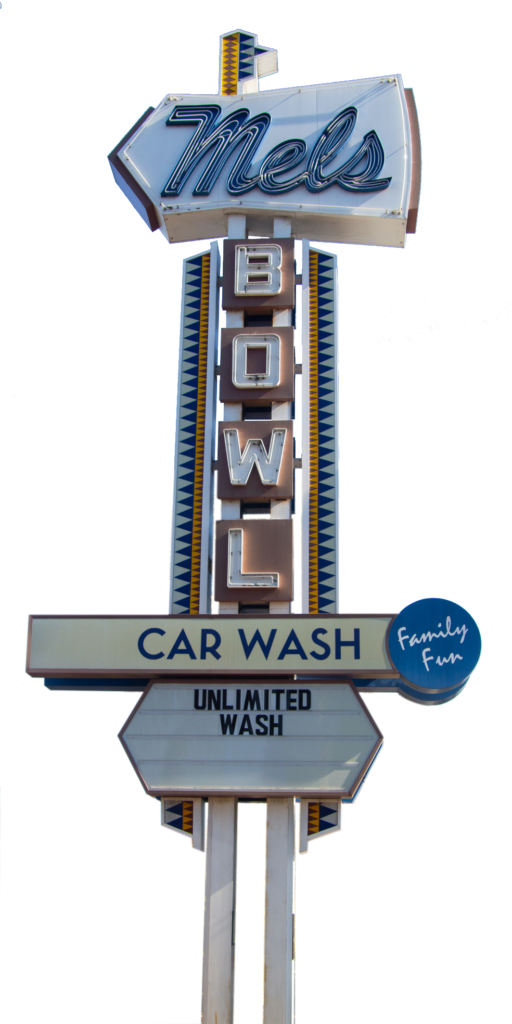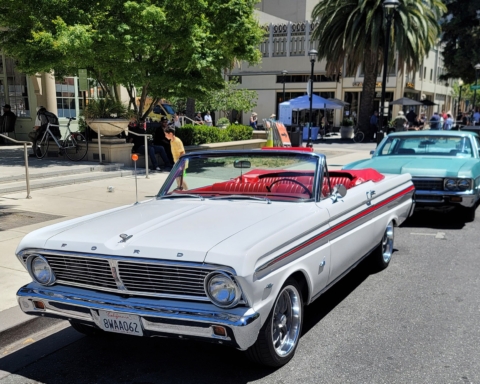By Heidi Van Zant
Driving on the Peninsula, where familiar vistas are continually being transformed by sophisticated high-tech offices and ultra-contemporary residences, it may seem like there’s “nothing to see here” when it comes to the unusual or even a little offbeat; nothing re-maining that’s startling enough to hit the brakes for a second look.
Call them “roadside attractions,” but they’re still here all right: A castle. A cemetery with a clown. A bowling alley sign relocated to a car wash. All have back stories—some qualify as bona fide “histories.” Some of the local landmarks have been controversial. Each rewards the curious in various ways, perhaps with a smile, perhaps a pleasant memory.
Climate chose these eight for a closer look:
- Circus Folks of America Memorial, Olivet Memorial Park, 1601 Hillside Blvd., Colma (located in the back left side of the cemetery in Section J). This huge granite headstone with the cheerful gold clown on the front is more touching than funny. Erected in 1945 when the Showfolks of America held its annual convention in San Francisco, this homage to the carnies and clowns of the world reads, “That they may rest in peace among their own.” Creepy clown sentiments notwithstanding, the memorial is actually a rather lovely, respectful place of repose under the towering trees, aptly known as “Showman’s Rest.” The last carnival worker was buried there in the mid-1990s.
- Sam’s Castle, 900 Mirador Terrace, Pacifica. This landmark sitting high over High-way 1 has been dropping jaws since 1908 when the grandparents of former Rep. Pete McCloskey built the 24-room mansion to look like a castle. Over the years its uses included a speakeasy and World War II military lookout, generating ghost stories galore before being abandoned. It was love at first sight for San Francisco interior designer and contractor Sam Mazza who bought the castle in 1959, then spent the rest of his life filling Sam’s Castle, as it came to be known, with art finds and good times. After his death in 2002 the Sam Mazza Foundation was created to host community events, tours and fund-raisers to benefit local community groups. Now temporarily closed and covered in scaffolding for renovations, it’s best to see Sam’s Castle on foot from a safe distance from the road. “At first, it creeps you out – all the stories you hear,” construction worker Andrew Sandoval said one recent morning. “I feel the ‘vibe’ and I’m glad I’m not working on the inside.”
- Flintstone House, 45 Berryessa Way, Hillsborough. Perhaps this tony town’s most famous – and for some, infamous – mansion is best seen whizzing by at 65 mph from the I-280 north freeway below. Exposed for all the world and miles of motorists to see each day, this home of funny concrete domes and round rooms caused grief from Day One for the shocked Town of Hillsborough. First sprouting in 1976 from its prominent hillside perch, bad feelings ensued immediately amid claims by neighbors that it was an eyesore that violated local design sensibilities. Owners came and went, the house color got changed from white to orange, and neighbors dubbed it the “Flintstone House.” When the newest owner, businesswoman Florence Fang, bought the place for $2.8 million in 2017, she added purple to the exterior color scheme and a mindboggling array of Flintstone characters, cartoonish prehistoric animals and colorful mushrooms. Hillsborough sued on the grounds her garden needed a city permit because of its size, and Fang sued back that the town was trying to intimidate her out of her love for Barney and Fred. Both sides just settled last summer, with Fang receiving $125,000 and the right to keep her Bedrock.
- Father Junipero Serra statue. Hillsborough rest stop on I-280, north of the Highway 92 intersection. Because of vandalism, the 26-foot-tall statue now sits behind lock and key, still ignobly overlooking the restrooms. Ana Yala, the attendant on duty during the day, estimates that on weekends she might have five or six requests but usually none during the week. The pudgy statue with big toes was erected in 1976 in a prime location with sweeping views of the Crystal Springs Watershed. From the start it was the target of pranksters and was recently splashed with red paint. San Carlos artist Louis DuBois donated the $2,000 cost of the statue, designed it and built the metal framework. But the application of the plaster coating was left to others reportedly including a mystery man named Mario who may have taken artistic license with the face to resemble his. The rest stop became a magnet for crime, made headlines when a homeless man took up residence to be-come its caretaker before a falling out with the state, and was closed for several years before being remodeled and reopened in 2011. The once-revered Roman Catholic priest credited with establishing Franciscan missions in early California is seen by many today in a much harsher light and appropriately deserving of a funky statue.

- Mel’s Bowl neon sign, Redwood City Car Wash, 215 El Camino Real, Redwood City. No, there’s no bowling while getting the car washed but there is some pretty good Redwood City nostalgia. The 41-foot-tall sign was moved to the car wash in 2012 after the closure of Mel’s Bowl, further south at 2580 El Camino Real where the sign stood since 1960. Steve Stern, 80, a lifelong San Mateo County resident, stopped to get his car detailed recently and admired the sign. “This is nice to see. Everything’s so homogenized these days,” he said. One side of the sign has been left as-is but the other has been adapted to advertise the car wash. But both sides still display the sign’s original, jaunty promise of “Family Fun.”

- Woody the Carved Fish. In the corner of the parking lot in front of Buck’s Restaurant, 3062 Woodside Road, Woodside. Granted, as roadside attractions go, Woody the Carved Fish is, ahem, a modest offering in the world of wacky stuff. His origins are in a bit of a dispute: Was he carved into a silver salmon from one redwood log in the early 1900s by Enoch Kadashan as legend and the plaque proclaim? Or was he whittled in 1974 for his first home at a fish hatchery in Orick and moved? Woody’s mum on the subject while the locals continue to treat him as a celebrity of sorts no matter what his birthright may be. “He gets decorated for all the holidays. I love it,” Woodside resident Nan Baly said with affection on her morning stroll as she gave Woody, now festooned in his latest Oktoberfest finery, the once-over.
- Facebook Thumbs-up billboard, 1601 Willow Road, Menlo Park. The newest of the landmarks on Climate’s roadside attractions round-up, this giant thumb—yep that one—is the ubiquitous Facebook thumbs-up “Like” symbol. It’s the one with the white hand and big thumb seen billions of times across the social media world. Positioned at the busy intersection of the Bayfront Expressway and Willow Road, the billboard stands sentry to Facebook’s bayfront headquarters at 1 Hacker Way. The foundation for the sign is the original Sun Microsystems monument, which was turned around a decade ago and covered with the ”Like” symbol when Facebook took over the campus. Facebook founder Mark Zuckerburg reportedly wanted to send a message to employees that they’d best stay on their toes and keep Facebook relevant to avoid a fate like Sun’s. “Like” fans can have a photo op from the car window or park behind the sign on the Facebook campus and use the crosswalk.
- Trompe-l’oeil murals, downtown Palo Alto. The outlandish murals of aliens crash-landing their spaceship into the side of a building or a man trying to cut the cables above an elevator are still getting smiles and doubletakes long after artist Greg Brown picked up his paintbrush to poke fun at the seriousness of life in his hometown in 1975. Using the style of art that creates an optical illusion, Brown was the city’s first Artist in Residence. “The Greg Brown murals are indeed treasured by the community and still delight visitors and residents,” said Elise DeMarzo, director of the Public Art Program for the City of Palo Alto. At Comerica Bank, the “Poor Parking Skills” alien mural adorns a wall over the parking lot while on another wall across the lot is a mural of aliens on a staircase being greeted by a bellhop. “People ask about them all the time,” branch manager Mehran Farahani said. For information about where to find the murals, check the cityofpaloalto.org website and search for “special projects and events” under the public art program.






